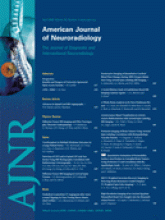Abstract
BACKGROUND AND PURPOSE: Differential diagnosis between malignant tumors and chronic infections in the masticator space remains challenging. The purpose of the study was to categorize various changes of both lesions by using single-voxel 1H-MR spectroscopy.
MATERIALS AND METHODS: Twenty-four masticator space lesions, 7 chronic infections, and 17 malignant tumors were assessed with 1H-MR spectroscopy before treatment procedures. The MR spectroscopic findings were compared with surgical and histopathologic results. Localization technique for 1H-MR spectroscopy was made by a point-resolved spectroscopy sequence at an echo time of 144 ms. Choline (Cho) signals (identified at 3.2 ppm) and Cho signal intensity-to-noise ratio (Cho/noise) were considered as evaluating criteria.
RESULTS: All the lesions were found with 3 1H-MR spectroscopic types: type 1, lesions without Cho signals (3 chronic infections); type 2, lesions with Cho signals and Cho/noise ratio <3 (4 chronic infections and 4 malignant tumors); and type 3, lesions with Cho signals and Cho/noise ratio >3 (13 malignant tumors). The mean ± SD of the Cho/noise ratio between chronic infections and malignant tumors was 2.31 ± 0.19 and 5.76 ± 3.29 (P < .01), respectively.
CONCLUSION: In vivo single-voxel 1H-MR spectroscopy may be helpful in the assessment of masticator space lesions. Differences of Cho signals and Cho/noise ratios between malignant tumors and chronic infections provide valuable information in the differentiation of these 2 lesions.
- Copyright © American Society of Neuroradiology












